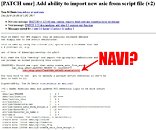Monday, December 18th 2017

AMD Navi Found Secretly Hiding in Linux Drivers
We know AMD has been doing a great job keeping the lid on their Navi architecture with information being scarce at the moment. Aside from knowing that Navi is being fabricated on the 7 nm process, it is possible that the microarchitecture will quite possibly support next-generation memory like GDDR6 or HBM3. In a Navi discussion on the Beyond3D forums, a user found an entry in a Linux driver dated back to July that apparently mentions AMD's upcoming architecture - not by its real name, of course. The code is to add support for importing new asic definitions from a text file as opposed to adding support in code. Tom St Denis, a software engineer at AMD, listed the output that would be generated by using this functionality. However, the entry that caught our attention reads: new_chip.gfx10.mmSUPER_SECRET.enable [0: 0]. If our memory serves us right, the codename for Vega was GFX9. So by logic, Navi should carry the GFX10 codename. Obviously, the SUPER_SECRET part further backs up our theory or maybe AMD's just trolling us. The red team has been hiring personnel for their GFX10 projects, so we can assume they're working diligently to release Navi some time next year.
Source:
Beyond3D

19 Comments on AMD Navi Found Secretly Hiding in Linux Drivers
Some more virtual reality for you: lets simply assume that AMD has been planning to sell Radeon (ATI) to Intel for years. So Raja would make Vega for Intel's MCM as a part of the deal. And AMD would already start working on next architecture that they'd keep later.
Makes sense?
Just few months ago Internet was full of hopes that Navi will be the first true born child of Raja. His style, his oversight from start to finish.
In short, bravo.
Not sure what digging you're referring to. I did some of that digging, but it was only to see what AMD had written yet around the time of the Vega FE launch. Info on "Vega 11" and "Vega 12" (which is still listed in parts of the Windows and Linux drivers) came elsewhere. Not sure if Vega 12 is a 12nm refresh part or not, but it's been in the drivers (in small pieces) for so long I assumed it was cancelled.
Latest windows drivers had 15 / 45w Raven Ridge FP5 test parts in them btw, + AM4 parts (2200G/2400G). Of course, the 15w parts already released. ;)
In a way... it was very Canadian.
Also AMD was very much like Intel, just a bit cheaper.
AMD concentrated on CPUs, ATI concentrated on GPUs. And both succeeded.
What happened after the fusion was this whole new approach of creating new kinds of products that have hardly any reason to exist and usually don't work.Do you own an APU? Where was the list time you had one? Do you plan to buy one? Seriously.
When they took over ATI, I though they just want to make great simple integrated GPUs - an idea so obvious that I expected it to become ubiquitous in following years (and it has in the blue camp).
But what they've actually made are vastly overpowered APUs (yet still not fast enough for serious gaming) and continue to make IGP-less systems. And they did it again with Zen.
Of course 6 year old APUs hold fine. My 11 year old Intel GMA is also perfect!
This is the whole point about IGPs. Essentially, they'll work for as long as the CPU does.
And of course the world is full of notebooks with AMD APUs. Good job AMD.
The Intel GMA in my 2006's notebook works just as well as it did back then. So why would I need a more powerful APU? Do you think you could sell me this product if I went to your computer store?
More importantly, when AMD decided that the world needs an APU for gaming laptops, mobile GPUs were awful, power-hungry, brutally shrunk desktop GPUs' cousins. So the actual idea wasn't as bad as the execution.
The problem is: modern mobile GPUs are rather brilliant - including the ultrabook-friendly MX150.
AMD didn't need to take over ATI to offer an IGP. And as far as business ideas go, we can't really say if this one was good or bad. What we can say, is that it didn't help.
We've all seen this graph, but let's look once again: www.cpubenchmark.net/market_share.html
I assume you know when this acquisition happened...
Also, why shouldn't Europeans be allowed to say "dude"? Would be "chap" better? Lad maybe?